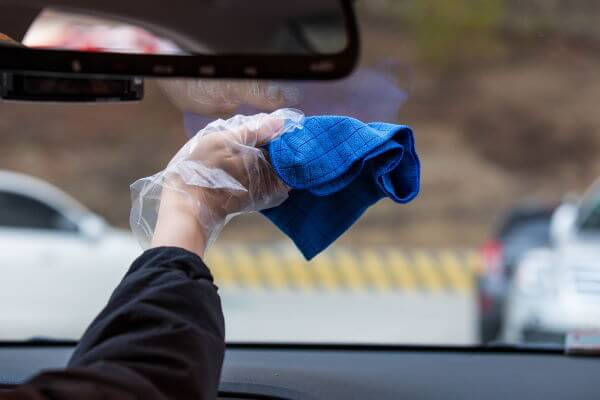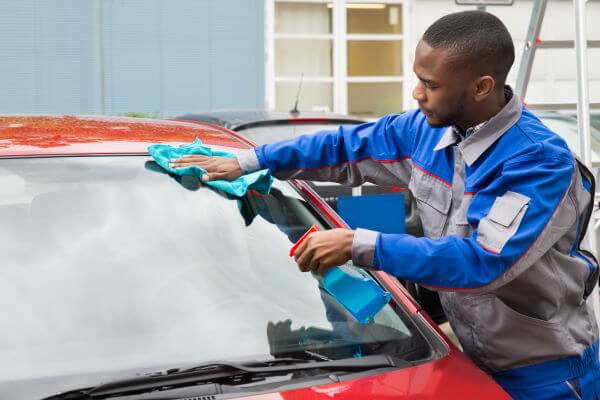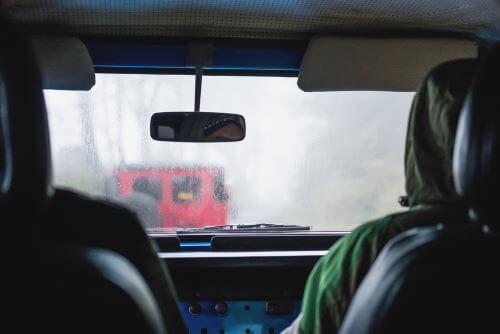I only notice the windshield haze either during the morning commute. when the sun is streaming in and the dirty, hazy windshield is making it hard to see.
Or, when it is raining out in the winter and the salt has caked up on the windshield, creating a haze.
Unfortunately, parking and waiting for the rain to pass isn’t an option because I’m always running against the clock.
The last thing you want while driving is for something to obstruct your view of the road. And that’s what makes windshield haze a foe. Haze buildup is a common occurrence.
Thankfully, it doesn’t take a genius to get rid of it. Here’s a quick guide on how to keep your windshield crystal clear.
What Causes Windshield Haze
Interior Windshield haze is a thin film buildup made up of airborne contaminants from interior materials, pollutants, gassing, and cleaning products. Let’s have a closer look at some of the common causes of hazy windshields.
Exterior haze is generally from salt, road grime, pollen, or pollution.
Cleaning Windshield Haze
- Lay Bath Towels on your Dash To Protect It
- Fill A Bucket with Dish Soap and Water
- Use a Terry cloth rag to clean the windshield with the dish soap mixture. Use a circular motion.
- Use a Squeegee to remove the liquid from the windshield for streak-free visibility.
- Apply Rain-x To the inside of the windshield as a preventative.
What Causes Windshield Haze?
Humidity
The humidity in the air can cause a little moisture to form on the inside of your windshield. This attracts dirt that then clings.
As the day heats up and the humidity evaporates, that residue remains.
This repeats daily, causing a build-up on the cleanest windshields and creating a haze.
Smoke residue
Cigarette smoke leaves a yellowish residue on the inside of the windshield. If you smoke regularly in your car, you’ll begin to notice a buildup of smoke residue in the sides of your windshield. It’s safer for you and others to smoke outside of your car.
Offgas from vinyl or plastic
As direct sunlight heats your car, the vinyl and other plastics begin to break down and evaporate onto the windshield. It often happens during the summer, and new cars are more susceptible to off-gas from vinyl or plastic.
Water & Mildew From The Floor
Moisture inside your vehicle can cause a haze to form on the inside of the windshield. Maybe you have an open bottle of water, or there’s mildew in the fabrics of parts of your car that never dried out. You need to get rid of all of those.
Engine or heater coolant leak
An engine or heater coolant leak can enter your vehicle through the front vents and form a green haze on your interior windshield. It has a strong smell and is not hard to miss.
Hard water, acid rain, dirt, & salt on the outside
An exterior windshield haze isn’t any different from an interior one. It may be caused by acid rain, hard water, dirt, pollen, or sea salt. If you live near the sea, you’re going to have this salt problem often.
See Related: Reach Your Windshield

7 Products to Remove Interior Windshield Haze from your windshield
Below are DIY mixes and branded products you can use to remove windshield haze. You may also contact your car manufacturer to be on the safe side.
1. Rain-x
Initially created for aviation windshields, Rain-x has become a go-to product for cleaning car windshields and wipers. You can add Rain-x Glass Treatment to your regular car wash tools and apply using a microfiber towel and a spray bottle. To get rid of ice on your car windows or windshield, you can use the Rain-x De-Icer washer fluid. These windshield cleaners and fog repellants also prevent interior windshield haze.
2. White vinegar and water
If you can’t afford branded products, then try this white vinegar and water DIY solution. It’s a cheap, accessible, and efficient remedy. Simply mix white vinegar and water. The recommended mix ratio should be 10% vinegar 90% water. However, you can increase the vinegar percentage, depending on the severity of your car’s windshield haze.
3. Ammonia-free Glass Cleaner Spray
If you can afford a branded ammonia-free glass cleaner, then you can try out Windex or Rain-x 2-in-1. Ammonia-free glass cleaners leave no residue when cleaning. Alternatively, you can make some ammonia-free glass cleaner at some. You’ll need rubbing alcohol, distilled water, white vinegar, peppermint essential oil, a glass spray bottle, and a funnel.
4. Cleaning Clay
Some particles bond to the glass and are more challenging to remove than other substances. These particles could be road tar, water spots, grime, grease, road films, or oil. Cleaning clay efficient removes stubborn gunk from your car windows and windshield.
5. Invisible Glass or Glass Cleaner Aerosol Product
If you’re tired of glass cleaners that leave visible streaks on your windshield, then try some invisible glass aerosol products. Invisible glass cleaners don’t contain any dyes, surfactants, or soaps, which may leave some residue behind.
6. Mr. Clean Magic Eraser
Mr. Clean Magic Eraser is a trusted cleaning tool for your glass window and windshield. It acts as safe sandpaper for removing stubborn grime buildup from auto glass, leaving your glass clear of any debris.
7. Rubbing alcohol
Rubbing (isopropyl) alcohol disinfects your car surfaces and leaves them streak-free when the job’s done. What’s more, isopropyl alcohol is safe to use on your car’s windshield and doesn’t affect your tint. All you need to make the rubbing alcohol solution is to mix two-thirds of isopropyl alcohol with one-third of distilled water.

Tips For Cleaning your Windshield
- The entire cleaning process can be condensed into two simple steps. First, spray your removal product on the windshield. Second, wipe! But, while you’re at it, there are few things to keep in mind.
- Wipe the glass with a squeegee or microfiber cloth. That needed to be said because sometimes you’ll be tempted to towels use paper towels instead. Paper towels, however, leave lint and residue behind and could cause streaking. See how that defeats the point?
- To remove grease, use your rubbing alcohol and another microfiber towel. And if you’re dealing with haze caused by sea salt, use vinegar. And makes sure not to use Ammonia on tinted windows
- Most glass or window cleaners will hurt your dashboard if they drop on it. So don’t forget to cover your dashboard with towels when cleaning.
- If one side of your towel gets dirty, turn to the other side or pick a new towel altogether. Don’t be lazy.
- Clean your windshield in a shaded area to avoid quick evaporation of glass cleaner fluid.
Should You Use WD 40 on Your Windshield
Yes. WD 40 is an excellent solvent for the safe removal of almost any substance from your windshield. Removable substances include tape, adhesives, and stickers.
 Skip to content
Skip to content


